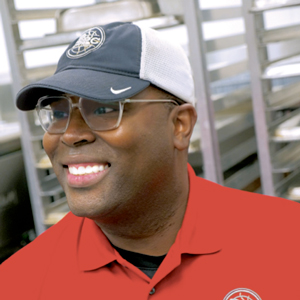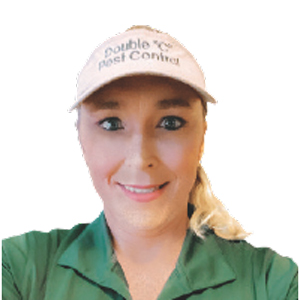
To reach deep into cracks and crevices where roaches — regardless of species — like to hide, Vaughn Thomas uses Control Solution Inc.’s Precision Delivery System tool with Doxem Precise dry flowable bait. Photos (Above and On the cover): AARON FREEMAN, FILM FACTORY LLC
When you were first learning the ropes of the pest management industry, you (hopefully) were taught that no two accounts are alike, and that a cookie-cutter approach will likely end in failure. This is particularly true for German cockroaches in commercial accounts. That’s not to say there aren’t similarities you can pick out before you begin an inspection, or that best practices and protocols are not needed. There are — hello, sanitation issues — and they are.
Running with that theme, since we are, after all, talking primarily about commercial kitchens, treating for cockroaches is not unlike baking a batch of cookies. You need flour, butter and eggs, but the different amounts used and what else you add can make them a different kind each time. And most times, as long as the basics are in place, you’ll get success.
The “basics” include:
- Tenacity: Inspect everywhere. Move objects. Ask for access to closets and cabinets, and don’t give up until you get it. Follow up, monitor, report and repeat.
- Talent: Cockroach technicians should be able to both follow the product label to a T and think outside the box when it comes to placing monitoring devices, for example. They should be able to identify species, even those that can be hard to distinguish, and know how to put together the best strategy for each situation. And while residential technicians need the “gift of gab” when explaining recommendations and expectations to homeowners, it’s a great quality for commercial techs to have, too. They need to be able to talk with more than just the main contact at an account, as the line cooks, the cafeteria volunteers, the second-shift crew all may have input as to where the cockroach issues are originating and spreading.
- Tools: You need more than the sole of your shoe for cockroach control, although it’s a good start. Baits, aerosols, liquids, dusts — each has their benefits, from quick knockdown to long residual to being labeled for use in food accounts. Vacuums, monitoring devices and formal reports are necessary for maintaining accounts and identifying hot spots before they become an issue.
- Time: Consider this the fourth “ingredient” — perhaps the sugar in your cookie. “A cockroach infestation in a residential home tends to be centralized in the kitchen, whereas in a commercial account, the source may not be coming from the area you were called out to service,” points out Vaughn Thomas, founder and president of Cleveland Heights, Ohio-based Cleveland Best Pest Control (CBPC). “You may need to search adjacent rooms and lower levels to find the epicenter of the problem.”
Gabby Cash, co-owner of Double C Pest Control in Weimar, Texas, agrees. “We place more emphasis on spending more time inspecting then treating,” Cash adds. “When a tech goes into a restaurant to perform a treatment, for example, whether it’s a maintenance or an initial service, they should go in with just a flashlight and inspect everything. Look behind everything, pull things away from the walls when possible, and get on your hands and knees to look thoroughly.”

PHOTO: SCOTT WROZIER
Scott Wrozier, ACE, a service supervisor for St. Louis, Mo.-based Rottler Pest Solutions, trains his commercial technicians to take the time to “think about why the pests are there before figuring out how to get rid of them.”
“Is there a seal where the floor meets the wall, or is there a gap? Is the drain below the equipment filled with food debris and trash? Did you crawl under the dish sink and check under the backsplash or around the motor?” he adds. “Our techs enter a new account with only their inspection tools; the products can wait until you know exactly what you’re going to do with them.”
COMMERCIAL VS. RESIDENTIAL
Educated as an engineer and marketer, CBPC’s Thomas started his business in 2019 after providing pest control for family-owned rental properties and falling in love with the work. He is primarily residential (a 70/30 split with commercial accounts), but last year won the bid for a local school system that has kept him very busy. Besides allotting more time at commercial accounts, he notes two other big differences from residential cockroach control:
1. More cooperation. Overall, he says, schools, restaurants, stores and other commercial clients tend to be more receptive to integrated pest management (IPM) recommendations. Naturally, they have more at stake (losing customers to cockroach sightings) than a person who has learned to live with the pests at home. But structural repairs and other advice go a long way to “getting and keeping control more quickly and for longer periods,” Thomas says.
2. More species variety. When we say cockroach, you say German — but Thomas warns against technicians becoming complacent with identification. “In commercial accounts around here, we have what I call the Big Three: American, Oriental and German cockroaches,” he says, referring to Periplaneta americana, Blatta orientalis and Blatella germanica. “Each requires a different treatment approach, as their habits differ slightly.”
Thomas says that at his accounts, German cockroaches are the most common overall, but that he finds American cockroaches near pipes in kitchens and restrooms that need attention. The problem usually is quickly brought under control once a leak is fixed or plumbing is replaced. Oriental cockroaches, meanwhile, are found near coolers and the back walls of kitchens. “Think of where, especially in older schools or other facilities, the kitchen is located,” Thomas points out. “They’re in the back of the building. And what’s right outside the kitchen door? The dumpsters.” While handy for keeping the kitchen area clean, he says, if dumpster and garbage can maintenance isn’t on a regular schedule, cockroach — and ant and rodent — populations can blossom.
With schools closed for much of 2020, Thomas says, he was able to get the majority of his school accounts onto either a two- or four-week rotating maintenance schedule, with callbacks as needed. “I charge a flat rate, and in return they are assured their school is as pest-free as possible,” he says, noting that ants, spiders and sowbugs also appear from time to time in certain schools. When Thomas began with the school system account, Oriental cockroaches were a big problem with a specific school’s old-fashioned coolers in the cafeteria, but were taken care of with Control Solutions Inc.’s Precision Delivery System, using Doxem Precise dry flowable bait.
Newer schools, with fewer cracks and crevices, are easier to service than older structures, Thomas says. He admits the worst — regardless of district — tend to be the cafeterias that are training kitchens for culinary students. “You have one half that is the main cafeteria kitchen, and it’s clean as can be,” he says. “And then the other half, that the students use for cooking classes — well, that can be another story.”

PHOTO: GABBY CASH
Double C’s Cash, who has been in the industry since 2013, points out that it’s easy to become complacent when the customer is cooperative and the cockroach level stays below the threshold. Approach every visit with both time and energy. “Don’t feel rushed,” she adds. “Doing a good job is more important than doing it quickly.”
Documentation with reports and photos also are essential at commercial accounts, Cash says. “We share our findings with clients, and inform them that if any areas we told them about that need sanitation are not remedied, there will be an additional charge for the follow-up visit. But if they do their part, the follow-up is free.”
Rottler’s Wrozier says after gaining control at a commercial account, it’s worthwhile to set up another appointment with your main contact. “Do a walkthrough of the account, and go over the progress that has been made,” he advises. “Identify the corrections made to conducive conditions, and point out how it has improved the pest activity. Then point out any conditions that have yet to be addressed, and come up with an action plan to correct them.”
While it’s not always possible, he says, “try to engage with staff as this process is happening, to get everyone on the same page. This also may be a time to add services, such as additional insect light monitors, drain treatments or exterior services.”
IDENTIFYING TRENDS
Wrozier admits that cockroach management in commercial kitchen environments has become more “interesting” in recent months, due in no small part to the ongoing COVID-19 pandemic. He says he believes there are several factors that contribute to the surge.
“We have accounts that did not allow vendors inside for long periods of time, including pest management services; we have our customers’ employees working from home part of the week, taking things like infested laptops to and from these environments,” he explains. “And in my experience, staffing issues have been exceptionally bad for the food and beverage industry. This means things like cleaning and organizing the kitchen get put on the back burner, if they are done at all.”
When facing these challenges, Thomas says, pest management professionals simply need to continue to do all they can to get cooperation from customers. “We must continue to work hard to educate our customers on the habits of these pests, and what best practices they can implement to reduce the risk of future problems,” he concludes.
The post Tenacity, talent and the right tools appeared first on Pest Management Professional.
from Pest Management Professional https://www.mypmp.net/2021/10/06/tenacity-talent-and-the-right-tools/
Sacramento CA
No comments:
Post a Comment